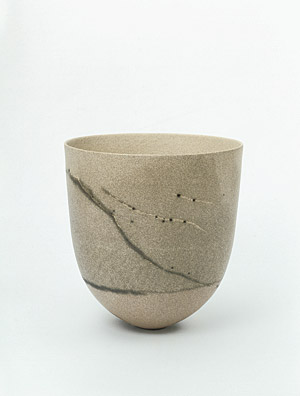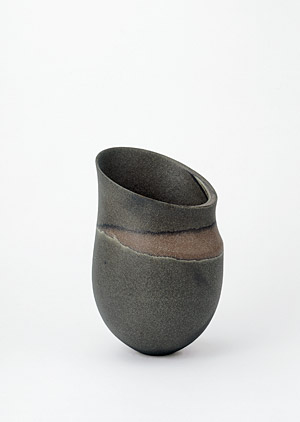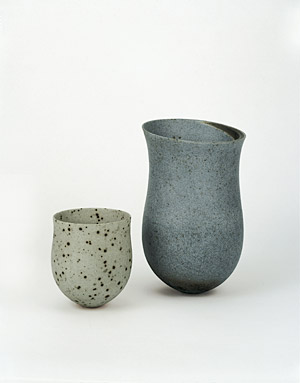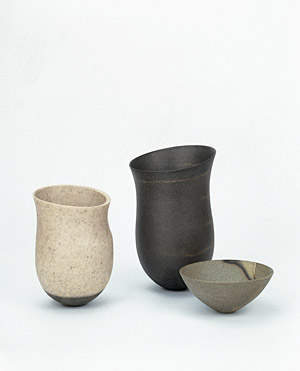Essays
curator,
ceramics and glass collection
victoria and albert museum Confronted by Jennifer Lee’s new group of pots in her south London studio, I am at once struck by their quiet but insistent beauty, their unassuming elegance, their balance and poise. Caught between movement and stillness, their fine, standing forms appear simultaneously rooted yet weightless, both silent and exerting considerable presence, holding within themselves a concentrated energy.
It is work that shows an extraordinary attunement to materials, an intense and committed relationship through which forms are painstakingly brought into being. And whether of classical profile or animated through disruptions to their contours, the resulting forms remain strong, balanced, and resolved.
Where might the significance, the meaning, of Lee’s work reside? What place can it have in our lives? These are not objects that are in any sense functional, although they certainly possess beauty. But are they simply beautiful things, beautifully crafted? I suspect they are much more than that.
To make pottery vessels by hand is to participate in a tradition of almost unimaginable depth and complexity. Lee’s pots remind us of this fact.Responding to their earthiness, their muted natural hues, their haloed bands and traces of colour, Lee’s pots have frequently and not unreasonably been compared to landscape, their tilted horizontal striations appearing like geological strata. Yet unlike some of the freer branches of organic ceramic sculpture, these are clearly not objects formed by natural processes, brought into being through the chance accumulation and manipulation of earth and rock. For the viewer who knew nothing of their age or origins, their status as human artefacts would be immediately apparent. They are, after all, ceramic vessels, one of the most universal and constant markers of civilisation. To make pottery vessels by hand is to participate in a tradition of almost unimaginable depth and complexity. Lee’s pots remind us of this fact. Timeless and ageless in character, their principle ceramic points of reference lie in the ancient world. Unsurprisingly, they appear as something enduring, objects whose presence is charged, yet the function of which remains partially obscure.
Such objects seem embedded in our consciousnesses, feeling somehow distant yet also familiar and known. In contemplating what lends them their charge, I am reminded of the cycles of Lewis Grassic Gibbon’s great novel, Sunset Song, which like Lee herself has its roots in Scotland’s north-east. Set within a small agricultural community in the first decades of the 20th century, Sunset Song, tells of the crisis in farming brought about by technology and the onset of war, and the tensions between continuity and progress. In its portrayal of the demise of crofting in favour of increased mechanisation and economies of scale - the passing of the age of “the man with the land closer to his heart than the flesh of his body" - it mourns the loss of a connectedness with things, and in doing so reflects many of the anxieties of our times.
Jennifer Lee’s pots are not created as an alternative to modern life, but they are a grounding presence within it.
Periodically throughout the novel, its heroine Chris Guthrie finds refuge from the personal and social crises that enfold her and her community at an ancient stone circle above her father’s croft, and it is from there that the story is told. The symbolism of the Standing Stones is complex, but for Chris they not only offer a place of reflection and peace, but also and more importantly, represent continuity with the past, signifying an enduring human presence within - and attuned to - the land. This sense of timelessness, of continuity and tradition, and of an enduring connectedness between humans and the world of things, seem exactly the qualities that are so strongly in evidence in the work of Jennifer Lee. Within it we can find the same reassuring sense of the human hand shaping beauty from the basic fabric of the earth, and of the ongoing connection between past and present. It is work that continues - as David Whiting has written - “to allude to natural and man-made archetypes, to history and the passage of time"
Through their meticulous manufacture, their lack of obvious utility, their continuity with the past, Lee’s pots defy the efficiencies demanded by technological society. Their power is assigned to them not only by virtue of their refined elegance, but also through the time and concentration of thought invested in their making, and their rootedness in one of humankind’s most enduring traditions. Jennifer Lee’s pots are not created as an alternative to modern life, but they are a grounding presence within it. A touchstone of permanency and beauty within the maelstrom.
Alun Graves
2008
Reproduced courtesy of Galerie Besson

25 x 24.8 cm

21.6 x 13.9 cm

14 x 12 cm
Slate-blue, graphite clusters, tilted olive shelf rim 2007
27.8 x 17 cm

Dark metallic, vanishing traces, tilted rim2006
26.8 x 16.8 cm
Speckled olive, haloed spiral 2007
7.3 x 16.4 cm